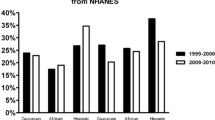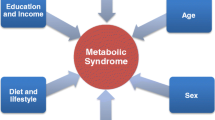Abstract
The metabolic syndrome is a clustering of cardiovascular risk factors and is associated with an increased risk of developing diabetes, cardiovascular disease, and kidney disease. Epidemiologic studies have demonstrated differences in prevalence by age, gender, and ethnicity. The prevalence of the metabolic syndrome increases with age through the sixth decade of life among men and seventh decade among women. Most, but not all, studies reported a higher prevalence of the metabolic syndrome among women compared with men. Although the metabolic syndrome is more common among Mexican Americans compared with non-Hispanic whites and blacks, among men the metabolic syndrome is more common among non-Hispanic whites than non-Hispanic blacks; the reverse is true among women. Understanding the basic pathophysiology underlying the metabolic syndrome may help explain the age, gender, and ethnic differences in its prevalence and guide preventive and therapeutic efforts.
Similar content being viewed by others
References and Recommended Reading
National Cholesterol Education Program (NCEP) Expert Panel on Detection, Evaluation, and Treatment of High Blood Cholesterol in Adults (Adult Treatment Panel III): Third Report of the National Cholesterol Education Program (NCEP) Expert Panel on Detection, Evaluation, and Treatment of High Blood Cholesterol in Adults (Adult Treatment Panel III) final report. Circulation 2002, 106:3143–3421.
Kahn R, Buse J, Ferrannini E, Stern M: The metabolic syndrome: time for a critical appraisal: joint statement from the American Diabetes Association and the European Association for the Study of Diabetes. Diabetes Care 2005, 28:2289–2304.
Alberti KG, Zimmet PZ: Definition, diagnosis and classification of diabetes mellitus and its complications. Part 1: diagnosis and classification of diabetes mellitus provisional report of a WHO consultation. Diabet Med 1998, 15:539–553.
Roden M: [Diabetes mellitus—definition, classification and diagnosis]. Acta Med Austriaca 2004, 31:156–157.
Ford ES, Giles WH, Dietz WH: Prevalence of the metabolic syndrome among US adults: findings from the third National Health and Nutrition Examination Survey. JAMA 2002, 287:356–359.
Ford ES, Giles WH, Mokdad AH: Increasing prevalence of the metabolic syndrome among US adults. Diabetes Care 2004, 27:2444–2449.
Grundy SM: Metabolic syndrome pandemic. Arterioscler Thromb Vasc Biol 2008, 28:629–636.
Reynolds K, He J: Epidemiology of the metabolic syndrome. Am J Med Sci 2005, 330:273–279.
Chen J, Muntner P, Hamm LL, et al.: The metabolic syndrome and chronic kidney disease in US adults. Ann Intern Med 2004, 140:167–174.
Galassi A, Reynolds K, He J: Metabolic syndrome and risk of cardiovascular disease: a meta-analysis. Am J Med 2006, 119:812–819.
Wannamethee SG, Shaper AG, Lennon L, Morris RW: Metabolic syndrome vs Framingham Risk Score for prediction of coronary heart disease, stroke, and type 2 diabetes mellitus. Arch Intern Med 2005, 165:2644–2650.
Kraja AT, Borecki IB, North K, et al.: Longitudinal and age trends of metabolic syndrome and its risk factors: the Family Heart Study. Nutr Metab (Lond) 2006, 3:41.
Ford ES, Li C, Imperatore G, Cook S: Age, sex, and ethnic variations in serum insulin concentrations among US youth: findings from the National Health and Nutrition Examination Survey 1999–2002. Diabetes Care 2006, 29:2605–2611.
Park YW, Zhu S, Palaniappan L, et al.: The metabolic syndrome: prevalence and associated risk factor findings in the US population from the Third National Health and Nutrition Examination Survey, 1988–1994. Arch Intern Med 2003, 163:427–436.
Sanisoglu SY, Oktenli C, Hasimi A, et al.: Prevalence of metabolic syndrome-related disorders in a large adult population in Turkey. BMC Public Health 2006, 6:92.
Hildrum B, Mykletun A, Hole T, et al.: Age-specific prevalence of the metabolic syndrome defined by the International Diabetes Federation and the National Cholesterol Education Program: the Norwegian HUNT 2 study. BMC Public Health 2007, 7:220.
Frontini MG, Srinivasan SR, Berenson GS: Longitudinal changes in risk variables underlying metabolic Syndrome X from childhood to young adulthood in female subjects with a history of early menarche: the Bogalusa Heart Study. Int J Obes Relat Metab Disord 2003, 27:1398–1404.
Grundy SM, Cleeman JI, Daniels SR, et al.: Diagnosis and management of the metabolic syndrome: an American Heart Association/National Heart, Lung, and Blood Institute Scientific Statement. Circulation 2005, 112:2735–2752.
The Lipid Research Clinics Program Prevalence Study. Circulation 1980, 62(4 Pt 2):IV1–IV136.
Chiu KC, Lee NP, Cohan P, Chuang LM: Beta cell function declines with age in glucose tolerant Caucasians. Clin Endocrinol (Oxf) 2000, 53:569–575.
Ford ES: The metabolic syndrome and mortality from cardiovascular disease and all-causes: findings from the National Health and Nutrition Examination Survey II Mortality Study. Atherosclerosis 2004, 173:309–314.
Malik S, Wong ND, Franklin SS, et al.: Impact of the metabolic syndrome on mortality from coronary heart disease, cardiovascular disease, and all causes in United States adults. Circulation 2004, 110:1245–1250.
Mozaffarian D, Kamineni A, Prineas RJ, Siscovick DS: Metabolic syndrome and mortality in older adults: the Cardiovascular Health Study. Arch Intern Med 2008, 168:969–978.
Lawlor DA, Ebrahim S, Davey Smith G: The metabolic syndrome and coronary heart disease in older women: findings from the British Women’s Heart and Health Study. Diabet Med 2004, 21:906–913.
Ferrara A: Increasing prevalence of gestational diabetes mellitus: a public health perspective. Diabetes Care 2007, 30(Suppl 2):S141–S146.
Mosca L, Ferris A, Fabunmi R, Robertson RM: Tracking women’s awareness of heart disease: an American Heart Association national study. Circulation 2004, 109:573–579.
Flegal KM, Carroll MD, Ogden CL, Johnson CL: Prevalence and trends in obesity among US adults, 1999–2000. JAMA 2002, 288:1723–1727.
Ford ES, Zhao G, Li C, et al.: Trends in obesity and abdominal obesity among hypertensive and nonhypertensive adults in the United States. Am J Hypertens 2008, 21:1124–1128.
Gu D, Reynolds K, Wu X, et al.: Prevalence of the metabolic syndrome and overweight among adults in China. Lancet 2005, 365:1398–1405.
Assmann G, Guerra R, Fox G, et al.: Harmonizing the definition of the metabolic syndrome: comparison of the criteria of the Adult Treatment Panel III and the International Diabetes Federation in United States American and European populations. Am J Cardiol 2007, 99:541–548.
Matthews KA, Meilahn E, Kuller LH, et al.: Menopause and risk factors for coronary heart disease. N Engl J Med 1989, 321:641–646.
Gami AS, Witt BJ, Howard DE, et al.: Metabolic syndrome and risk of incident cardiovascular events and death: a systematic review and meta-analysis of longitudinal studies. J Am Coll Cardiol 2007, 49:403–414.
Tan CE, Ma S, Wai D, et al.: Can we apply the National Cholesterol Education Program Adult Treatment Panel definition of the metabolic syndrome to Asians? Diabetes Care 2004, 27:1182–1186.
Alberti KG, Zimmet P, Shaw J: The metabolic syndrome—a new worldwide definition. Lancet. 2005, 366:1059–1062.
Lee ET, Welty TK, Fabsitz R, et al.: The Strong Heart Study. A study of cardiovascular disease in American Indians: design and methods. Am J Epidemiol 1990, 132:1141–1155.
Berlie HD, Herman WH, Brown MB, et al.: Quality of diabetes care in Arab Americans. Diabetes Res Clin Pract 2008, 79:249–255.
Jain T, Peshock R, McGuire DK, et al.: African Americans and Caucasians have a similar prevalence of coronary calcium in the Dallas Heart Study. J Am Coll Cardiol 2004, 44:1011–1017.
Vega GL, Adams-Huet B, Peshock R, et al.: Influence of body fat content and distribution on variation in metabolic risk. J Clin Endocrinol Metab 2006, 91:4459–4466.
Haffner SM, D’Agostino R, Saad MF, et al.: Increased insulin resistance and insulin secretion in nondiabetic African-Americans and Hispanics compared with non-Hispanic whites. The Insulin Resistance Atherosclerosis Study. Diabetes 1996, 45:742–748.
Laclaustra M, Corella D, Ordovas JM: Metabolic syndrome pathophysiology: the role of adipose tissue. Nutr Metab Cardiovasc Dis 2007, 17:125–139.
Author information
Authors and Affiliations
Corresponding author
Rights and permissions
About this article
Cite this article
Razzouk, L., Muntner, P. Ethnic, gender, and age-related differences in patients with the metabolic syndrome. Current Science Inc 11, 127–132 (2009). https://doi.org/10.1007/s11906-009-0023-8
Published:
Issue Date:
DOI: https://doi.org/10.1007/s11906-009-0023-8




